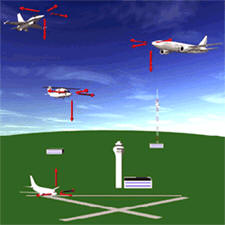
 |
|
|
|
|
|
|||
|
Watch And Hear What Some Industry Experts Have To Say |
||||
 |
ADS-B is one of
the most important, underlying technologies in the agency’s plan to
transform air traffic control to a satellite-based system. It is an air
traffic system that will provide more precise surveillance data to air
traffic controllers and to ADS-B equipped aircraft at the same time.
This information will significantly enhance pilots’ situational
awareness. This technology provides more precision for tracking aircraft
than radar by giving the location, identification, heading and speed. In
addition to the surveillance data (traffic) being provided, it will also
broadcast weather information to properly-equipped aircraft. ADS-B will
bring the precision and reliability of satellite-based surveillance to
the nation’s air traffic controllers and pilots.
ADS-B uses Global
Navigation Satellite System (GNSS) position information processed by
aircraft avionics to transmit the aircraft’s location to ground
receivers for presentation to air traffic controllers. |
|||
|
What are
the benefits of ADS-B?
With ADS-B, pilots for the first time will see the same kind of
real-time traffic displays that are viewed by controllers. This will
dramatically improve pilots’ situational awareness, since they will know
where they are in relation to other aircraft, bad weather and terrain.
This technology is already showing benefits in safety. In In addition to improved safety in the sky, ADS-B will help reduce the risk of runway incursions. Both pilots and controllers will see the precise location on runway maps of each aircraft and equipped ground vehicles, along with data that shows where they are moving. These displays are clear and accurate, even at night or during heavy rainfall. |
||||
|
ADS-B will
also increase capacity.
More accurate
tracking could eventually allow aircraft to fly safely with less
distance between them. Because ADS-B accuracy also means greater
predictability, air traffic controllers will be better able to manage
the air traffic arriving and departing from congested airports,
resulting in even more gains in capacity.
With its combined
increases in safety, efficiency, and capacity, and reductions in cost,
ADS-B is critical to the agency’s Next-Generation Air Transportation
System.
Why adopt ADS-B?
Radar technology
is essentially a product of 1940s’ World War II technology. Radar
occasionally has problems discriminating airplanes from migratory birds
and rain “clutter.” Secondary surveillance systems can determine what
objects are because they interrogate transponders; however, both primary
and secondary radars are very large mechanical structures that are
expensive to deploy, require extensive maintenance, and require the
agency to lease land on which to situate them.
ADS-B, on the
other hand, receives data automatically from the aircraft, rather than
scanning for input like radars. ADS-B ground stations are inexpensive
compared to radar, and are considerably smaller. They take up less space
and can be located practically anywhere. In addition, ADS-B updates once
a second and locates aircraft with much higher precision.
ADS-B also
provides greater coverage, since ADS-B ground stations are so much
easier to place than radar. Remote areas where there is no radar now,
like the Gulf of Mexico and parts of
Who will
install the ground stations?
The FAA has begun
implementing ADS-B in the national airspace system. This means expanding
the current infrastructure within various portions of the
ITT Corporation
was selected in August 2007 as the prime contractor for the deployment
of the ADS-B radio infrastructure. Under the terms of its contract, ITT
must have the system ready for commissioning by 2010 and enough stations
in place by 2013 to provide ADS-B coverage everywhere there is radar
today.
As the ADS-B radio
infrastructure expands, ITT, Corp will likely use the system’s
capabilities to offer commercial services to private pilots and
airlines.
What about
aircraft avionics?
The agency issued
a notice of proposed rulemaking in 2007 asking for public comment on the
avionics necessary for implementing ADS-B across the national airspace
system. Under the proposal, operators would equip their aircraft with
avionics based on the airspace in which they plan to operate. The FAA
expects to issue a final rule by spring 2010 that would mandate ADS-B
avionics in certain airspace by 2020. With national coverage complete by
2013, benefits in improved safety and capacity, and better efficiency
for users, will accrue as more and more users equip.
In December 2009,
the standards were approved for ADS-B avionics. Approval of the minimum
operational performance standards (MOPS) and related Technical Standard
Orders (TSOs) gives vendors and operators assurance that the equipment
meeting those standards will fulfill the requirements of the ADS-B rule.
Where is ADS-B
being rolled out?
ITT has installed
11 ground stations in
To prepare for the
national commissioning slated for September 2010, the agency is
implementing ADS-B at several key sites. Controllers began using ADS-B
to separate and manage aircraft in
The FAA brought
ADS-B to the Gulf following a Memorandum of Agreement with the
Helicopter Association International (HAI), helicopter operators, and
oil platform companies.
This will greatly
improve the safety and efficiency of aircraft flying over the Gulf,
since radar coverage does not extend over water. Controllers tracking
aircraft flying over the Gulf must rely on reported — not actual —
position information. In order to keep aircraft safely separated, a
significant amount of airspace must be “sanitized” around each aircraft,
severely reducing capacity. At low altitudes, individual aircraft are
isolated in a 20-mile-by-20-mile grid. At high altitudes, commercial
aircraft are separated by as much 120 miles in-trail.
Under the
agreement, the FAA is getting valuable space, power, and
telecommunications where available from the oil platforms to the shore
for the ADS-B ground stations, weather stations, and the radio
communications stations installed by the FAA.
Proposed Mandate
The FAA announced
a dual link decision using the 1090MHz ES and UAT mediums for ADS-B, and
has proposed a mandate that all aircraft have ADS-B Out capabilities by
January 1, 2020. At AOPA's recent |
| ©AvStop
Online Magazine
Contact
Us
Return To News
|
|